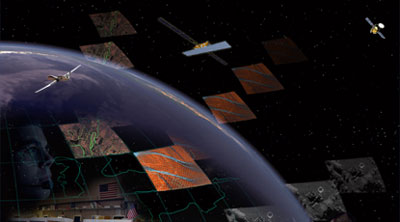Letter: solar power satellites and space radarby Dwayne A. Day
|
| It also seems odd to refer to 2010 as “long term” for any space platform. That is only two and a half years away, much less than the typical development time for even a small satellite using existing technology. |
The stated goal of developing this beamed solar power technology in order to make Space Radar “more stealthy” is also puzzling. Space Radar is an active emitter. Active emitters can be made stealthy through complex and classified methods such as narrow beam actively-scanned frequency-hopping arrays (witness the F-22 Raptor’s radar). However, it is unclear if any progress has been made at doing this for the kind of radar being envisioned for Space Radar, or if that is even possible. This is presumably a significant technological challenge and eliminating the need for solar panels on the satellite may have no real effect on the satellite’s stealthiness. Stealth for radar satellites—and the systems needed to achieve it—seems to be the kind of subject best left to satellite systems engineers.
The article also states that an initial test satellite could be launched immediately and an even more sophisticated one can be launched by 2010. Considering that the modern incarnation of Space Radar was initiated about a decade ago and has yet to result in a launch, this schedule seems optimistic. It also seems odd to refer to 2010 as “long term” for any space platform. That is only two and a half years away, much less than the typical development time for even a small satellite using existing technology, not technology that has not been developed yet, like a space-based Airborne Moving Target Indicator. The rule of thumb is: large satellites with new technology take at least seven to ten years to develop (the James Webb Space Telescope will take at least 15 or more), while small satellites with current technology take three to five years to develop. NASA has stated that building even a small satellite in three years increases risk and four years is better. We apparently do not even have the less challenging Ground Moving Target Indicator technology yet, and it therefore seems prudent to walk before we skip.
Finally, it is worth noting that Space Radar has experienced significant programmatic upheaval in past years not because of a “power problem,” but because the Air Force and the intelligence community have been at odds about what it should actually do and how different requirements drive the design and the cost. In addition, the Air Force has done a poor job of explaining why such a maddeningly expensive system is necessary.
The CBO report is fascinating reading and recommended for anybody interested in the subject.
